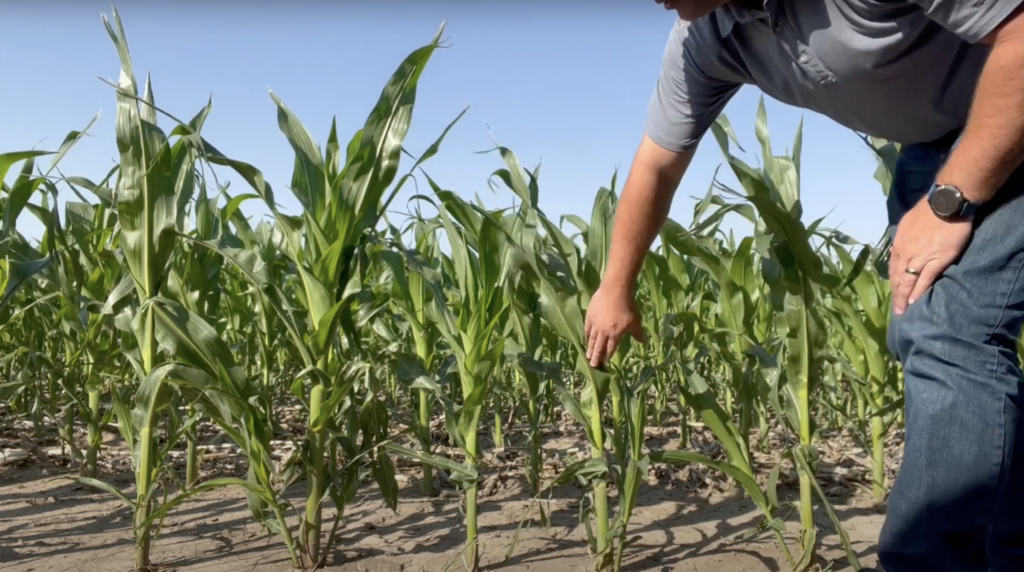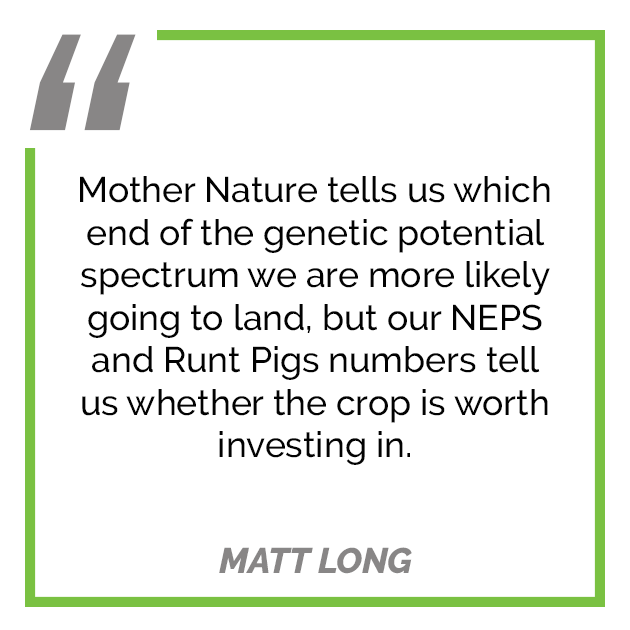Every company out there has a standard for seed quality, and if you do some digging you’ll find in their literature a phrase that states something like, “at [insert company name] we ensure the highest quality standard in the industry in every bag.” But did you know there are few explicit industry standards when it comes to the quality of the seed you purchase? And do you, or should you care?
Axis Seed takes a different approach to seed quality, one that you should care about. In fact, at Axis Seed, our quality standards start long before the seed crop is planted in the field, and don’t end until you are a satisfied customer. Why? To put it simply, the quality of the seed you plant is the foundation to your success at harvest.
To learn more about why this is important to your farms success, watch this short video before reading on:
Ensuring consistent and reliable seed quality takes a commitment to high standards and an attention to detail at every step of the development process, which is why Axis Seed partners with seed production and germination testing experts, Remington Seeds and SoDak Labs. respectively.
Remington takes pride in the quality they deliver and ensures every step of the seed production is done with quality in mind. SoDak then tests the seed to confirm we are delivering that quality in every bag. At Axis Seed, one of the things that sets us apart in the industry is the requirement of an 85% minimum on a saturated cold germination test from the toughest cold germ test in the industry, SoDak Labs.
SoDak Labs’ saturated cold germination test is a high stress vigor test that occurs over a 10-day period. Their rigorous testing emulates imbibitional chilling shock and low oxygen microclimate, similar to planting at 50℉ soil temperature and receiving significant rain immediately after planting.
So why am I harping on seed quality in today’s blog?
To put it simply, the quality of the seed you plant is the foundation for the yield you harvest. And not only does increasing harvestable ears per acre make driving the combine fun in the fall… it sets the stage for profitability for seasons to come.
Now let’s dig into a few practices and agronomic management techniques that will help you steward this quality seed from planting to harvest, and increase your yields along the way:
The “Runt Pig” Test
One of the first measurements of success when evaluating your current crop is stand establishment. At Axis Seed–Red Barn, we take things a step further than just noting which plants have emerged and which have not. The way we do this is through the “Runt Pig” test, also referred to as “Net Effective Plant Stand or NEFS.” If you’re new to this term or don’t recognize it from last year’s scouting reports, watch our quick video on the topic here.
The reason it is important to understand the quality of the stand and not just the numerical value of it is because “Runt Pigs” steal yield. We start early season evaluations with the “Runt Pig” test because it’s our first opportunity to determine what your yield potential is and it gives us a read on whether we should continue to invest in a crop if the conditions exist for maximum yield. When scouting, we determine a plant’s runt pig status by identifying plants that are one, two, or more growth stages (leaves) behind the plants immediately surrounding them.
You may think a few smaller plants doesn’t seem like a huge deal, but the ultimate impact can take down yield in a big way.

When you have a plant that’s one leaf (or growth stage) behind the plants surrounding them, that plant yields about 30–35% less than the other plants in its vicinity. These smaller plants are simply not as competitive as the surrounding plants. Their growth disadvantage starves them of sunlight, nutrition and water, which is why we see yields decline on plants that are just one leaf behind in growth. And, when a plant is two growth stages behind, this effect compounds and we see 50–65% less yield on that individual plant.
Ultimately, that high seed quality standard from Axis Seed helps reduce the quantity of runt pigs in your fields. High quality seed with high early vigor scores helps get your field off to an early and even start, and an even stand of corn is an important factor in high yields. When you eliminate runt pigs, your harvestable ears per acre increases, you achieve the genetic potential of the hybrids in your portfolio, and you maximize yield!
Investing in a Good Crop
“Runt Pigs” are under a lot of stress, they germinate and emerge slower than the rest of the plants but continue to compete for sunlight, water and nutrients. And because of the stress the runt pig is under, by the time this crop gets to the end of the season, the runt will be one of the first to die. Throughout the season, anytime that runt is starved for something it needs, it starts secreting ethylene, the hormone that causes early ripening. And at the end of the season, it will cause the other plants around it to start maturing faster than usual. So not only did this plant lose yield on its own throughout the season, but it caused the other plants around it to also lose yield.
Why are you getting Plant Physiology 101 in an EZ Ag Post?
Because the secretion of ethylene ties into one of the most common uses of in-season fungicide.
When there’s no significant disease pressure in a field but you are using fungicide you are banking on getting a return from the “plant health benefits” of the fungicide. One of the biggest benefits though is the reduction of ethylene production by the plant, ultimately slowing the ripening process of the corn crop and extending the grain fill period of that plant which increases yield.

You can assess the number of runt pigs in your field very early, I like to do it before the corn gets Knee High – which is before the 4th of July according to the old timers! Assessing the number of Runt Pigs helps you understand the number of full harvestable ears you can expect to have in the fall and whether or not the crop is worth the $17-dollar-an-acre fungicide investment mid-season.
Harvestable Ears per Acre
All of this talk about seed quality and Runt Pigs really comes down to one thing: Harvestable Ears per Acre, which in turn equates to yield when the combine rolls through the field. And since we are on the early end of evaluating our stands with the Net Effective Plant Stand (NEPS) evaluations we do, why wouldn’t we go ahead and tell you how this same evaluation can be turned into an early season Yield Estimate!
Yield estimates are tricky, just ask anyone who has ever done them, at times they may be spot on, other times just brace yourself as they can be 50% off, which in some cases can amount to an error of over 100 bushels per acre. Understanding where populations typically peak out in genetic potential helps us make better yield estimates early in the season. Now there’s one major caveat to this – the house always wins. And in this case, Mother Nature is the house.
We can control most all variables in crop production – and I’ll even be as bullish to say with the right plan we can control most of the variability thrown at us by Mother Nature, but there are instances where we cannot – in those instances these numbers (also known as peak genetic potential) do not apply.
Peak Genetic Potential Benchmarks for Western, KS
- Dryland: 7-12 Bu/1,000
- Limited Irrigation: 8-11 Bu/1,000
- Irrigated (>26kpop): 8-10 Bu/1,000
So, let’s quickly look at how we use Runt Pigs and Harvestable ears per acre to calculate early season yield estimates.
First, we take a stand count – the old school way, for this example we will say we have 16k plants per acre. Then we are going to do a NEPS count by determining the number of Runt Pigs and their effect on the final yield, here we’ll say we have 15 runts, bringing our NEPS to 94%. Now let’s put these numbers to the yield test, first take the stand (16K) multiplied by our NEPS (94%) multiplied by our peak genetic potential (7-12 Bu/1,000). Here we come up with a range of 105 Bu/A to 180 Bu/A.

Let’s run through another example quickly so you get a better idea of what the effect is. Here we have the same 16k stand but we have a 78% NEPS rating, now if we do the math, we know our range is 87 Bu/A to 149 Bu/A and really the top end of this crop is likely gone unless all the stars align because we have 22% of our plants out there pumping this field full of ethylene!
Granted those are broad ranges, but it gives us a baseline for decision making moving forward. If I have a 94% stand in July with a full profile and rain in the forecast, I am more likely to throw some extra groceries (fungicide and foliar fertilizer) at a crop than if I have a 78% stand or if I have that same 94% stand and no rain in sight with a heat wave on the way. Mother Nature tells us which end of the genetic potential spectrum we are more likely going to land, but our NEPS and Runt Pigs numbers tell us whether the crop is worth investing in.
So, are you in control of your yield?
There’s really only one way to start that process, and that’s by starting with a quality seed brand you can count on to deliver more yield in your field. That quality comes from Axis Seed, and it starts long before the seed is bagged and delivered to your farm, it starts with quality control in the production, processing, treatment, and testing, and ends when your trucks cross the scales.
At Red Barn Enterprises, we arm you with information because not only do we hope you’ll make your seed investment with us but that you’ll also give us the opportunity to partner with you throughout the season so we can walk your fields with you side-by-side and be a sounding board when it comes to making investments to push performance on your operation.
To learn more about how we can help you, contact us today!
This post was written by Axis Seed – Red Barn Enterprises President and resident corn expert, Matt Long.

Leave a Reply